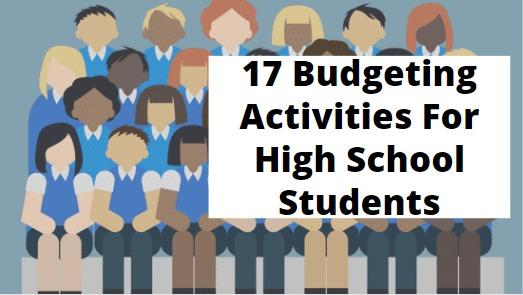Game-based learning is an exciting and successful method of educating kids.
It is perfect for teaching students how to handle money since it allows them to learn from their own decisions.
Teaching kids how to budget doesn’t have to be a headache if you engage in budgeting exercises. However, have you ever noticed how tough it is to come out GOOD, entertaining budgeting tasks?
After spending a few hours exploring the internet for the most acceptable FREE alternatives available, I’ve just realized the issue.
Here are 17 popular free game ideas for high school students to learn how to manage their money.
01. Play A Game Of “The Price Is Right.”
Experts recommend a guessing game as one possible thing to do.
Engage your children in an honest discussion about what they believe their family spends money on.
Afterward, have your teen come up with an estimate for each of the things.
He admits that it “may be something that goes on forever.” Get them to input their monthly expenses, such as ‘Gas, or whatever,’ and let them put it up.”
More on this budgeting activity: 12 things I learned at ‘The Price Is Right Live’ in Hershey
02. Create A Budget For The Activity
It is said that making the family budget together is an apparent budgeting activity to perform with a teen.
Adding excitement to the lesson is as simple as showing the teen how money may be saved for vacations or amusement.
It’s also a good idea to use budgeting as a way to get youngsters excited about participating.
They may earn a modest bonus if they don’t spend all of their allowances each month.
03. Turn The Budgeting Process Into A Game
If your children enjoy board games, make the budget into a game they can play together. Gabrielle Blair, a California mom of six, devised a game for her Design Mom blog in which children “go through 12 months of budget, and each month they have additional hurdles thrown their way.”
A minimum amount in phony savings was required, as was a specific number of fictitious “Social/Mental Well-Being Points,” she says.
It’s reminiscent of the old
04. Make Use Of The News
Sit down with youngsters from time to time and look at news stories that could influence their budgets, such as new taxes or legislation,”. Focus on what youngsters are interested in to make this activity more attractive to them.
For instance, which electrical company does they prefer?
Think about how investing in different stocks from well-known corporations will affect your personal retirement funds.
05. Experiment With The Overall Picture
One teacher of High school, Alexander Geruschek, says of his students’ favorite courses is Build Your Stax.
To teach their kids about budgeting while they are still in high school, parents may utilize this enjoyable activity.
It takes 20-30 minutes and each tick represents a year.
Players start with $1,000 to invest in stocks and bonds.
To do so, we must save as much money as possible during the next two decades.
This teaches you to save.
06. Consider Using ‘app’-Based Budgeting Solutions
If your kids have smartphones, get them the Mint app. In addition to a pie chart and bar graph, the software ties to the user’s bank account.
Set spending restrictions for different categories and get alerts when they’re nearing.
A computer programme that shows how small things build up.
It makes people think about their purchases.
Parents may use the app to track their children’s spending and save money.
07. A Review Of Regional Housing Costs
Students are tasked with analyzing the finances and position of Trish and Scott, a couple from Annapolis, MD, who wish to relocate because of a job offer from somewhere else.
Whether students accept a new work offer, they must look into the housing expenses to determine if they can afford to accept the position and relocate.
It’s essential to acquire money lessons early in life (mainly because young adults are least able to afford high-cost-of-living areas)
08. The Jelly Bean Game Of Sarah And Jessica
Hand out 20 jelly beans to each group of pupils (advise them not to eat them!).
The party then chooses how to spend the 20 jelly beans, taking into account the monetary worth of each bean, as well as spending requirements vs. wants.
Each time they play, they’ll have to cope with a new circumstance, such as someone breaking their limb (did they choose to spend on insurance?) or earning a promotion at work.
09. Money Skills That May Be Used In The Real World
Is there a particular way of life that your pupils would prefer?
This reality check tool allows them to evaluate their alternatives and expectations (such as the type of money they’ll require).
What are the difficulties for their future plans?
How much money do they need to live on?
10. Make A Shopping List
Set a budget-friendly meal prep goal for your students!
- For genuine grocery trips, either seek permission slips and funds from families or create a fictitious shopping list with the help of an online service.
- Encourage pupils to plan and prepare their own meals for a week’s worth of consumption.
- Students evaluate their spending habits after the week.
- Did they have enough food, or was it too much?
- Was the food that they bought healthy?
- This game teaches students about the connection between good financial practices and overall well-being.
11. Assist Them In Comprehending How Their Needs And Desires Have Evolved
Consider using a photo slideshow as your primary visual aid to demonstrate how human lifestyles have evolved throughout time. In the past, a smartphone, for example, was not deemed necessary. Ask students to forecast future needs, and then show them historical and present items to classify into piles of necessities or wants. Their ability to engage in metacognition—reflecting on their ideas, habits, and choices—increased by encouraging them to think about needs rather than desires.
12. Demonstrate To Children The Importance Of Saving
- First, kids must learn to pay their own expenses.
- Assign each child a fictitious savings account and a random amount from each “paycheck” to deposit into it.
- Ask them to conduct some research and draw some comparisons.
- Then teach them how to calculate their annual savings.
- Graph the kids’ savings accounts after six weeks to show how much they saved.
- To calculate a monthly savings budget, students should divide their total savings by 12 and compare it to their monthly spending budget.
13. Use Interactive Games To Make Budgeting Ideas More Enjoyable
It’s meant to have students thinking about prior spending decisions and new ways to look at spending patterns as they play the Bouncing Ball Budgets game.
The game will require them to listen attentively, work in teams, and think critically as they pass the ball and answer questions about their money habits.
14. Introduce The Concept Of Risk
Long-term saving strategies differ like the tortoise and the hare. Choose from high- and low-risk investment methods at random.
Then have students work in groups to determine how much money they’ll save throughout five, ten, twenty, thirty, and forty years.
Lastly, ask them to consider which method would be most effective in light of their objectives and current stage of life.
15. Credit clash
To understand credit ratings, you can play a game called Credit Clash. Brett Shifrin, a teacher at Maine’s Gould Academy, noticed that when his pupils’ credit scores rose, their prospective loan payment amounts decreased because they received loans with lower interest rates.
As one of his pupils put it, “taking out many loans and being able to pay them all substantially improves your credit.”
16. Uber-based sport
In this game, a full-time Uber driver with two kids is attempting to pay off the mortgage. Students may learn about the gig economy by playing a game created by The Financial Times. ‘Seems easy, right?’ says Lois Stoll, an Ohio Family, and Consumer Science instructor.
It is possible to earn money as a taxi driver in the gig economy. Don’t pay your mortgage while driving an Uber for a week. It’ll flop.
Things aren’t as simple as you would think
17. Payoff
Students who work as video bloggers have a lot on their plates.
They have a significant competition coming up, and they also have to cope with money problems and other unanticipated circumstances.
On the phone-simulating interface, players may check their bank balance or go to fake websites.
An immersive and engaging experience requires the player to help their fictitious character make sound financial decisions.




